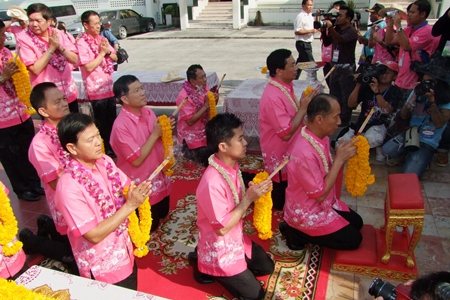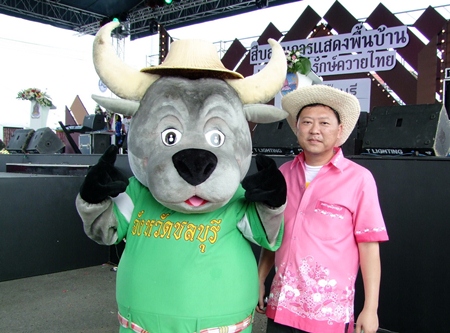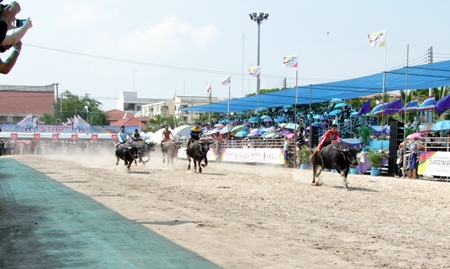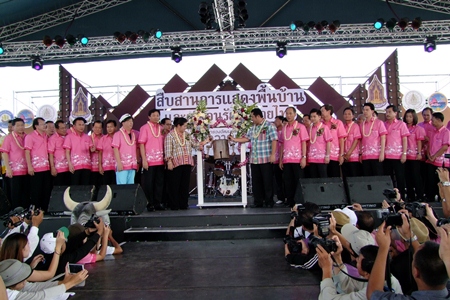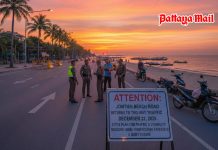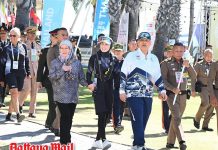Beefy, skinny or white, buffaloes of every kind thundered over a 100-meter track in Chonburi, astounding crowds with their terrific speed – and poor sense of direction – as the province hosted its 141st annual buffalo races.
Jockeys rode more than 100 of the beasts from across the kingdom down the dirt track in races offering both serious cash prizes and laughs. Provincial officials this year spiced up the proceedings, bringing in renowned comedians Teng and Nong to run a race with buffaloes.
The Oct. 26-Nov. 1 festival outside Chonburi City Hall also highlighted traditional heritage, including the annual “Kwienkan” parade and the sale of locally produced products.
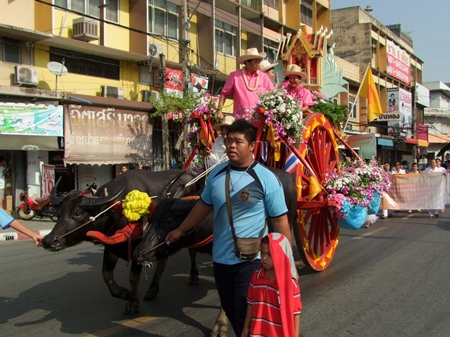 Sonthaya Kunplome and friends ride through the streets of Chonburi at the head of the opening day parade on a fabulously decorated buffalo drawn cart. (Photo from CPRD)
Sonthaya Kunplome and friends ride through the streets of Chonburi at the head of the opening day parade on a fabulously decorated buffalo drawn cart. (Photo from CPRD)
More than 300 Chonburi businesses offered their wares and food while other booths featured games including sand-piling, sugarcane eating, sling shots, puzzle games, joke poems, and buffalo-decorating contest. Thai country music and performances from acts such as Kalyani entertained while people entered drawings for gold prizes and enjoyed traditional Thai massage.
The competitions began Oct. 28 with a tug-of-war between a buffalo and national weightlifters following. Well-known musical acts, including Carabao, Surachai Chantimathon and Sudarat Butprom entertained in the evenings.
As for the races themselves, competitions were divided into categories for super junior, junior, middle, senior and super champ buffaloes. There were also contests for the best decorated, beautiful and comedic buffaloes, and a breeding contest.
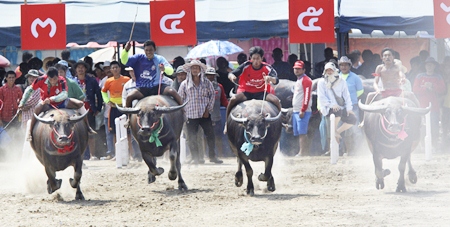 The faces of the jockeys tell it all – from crazy laughter to shear terror, as the thunderous beasts take off from the starting gate. (AP Photo/Sakchai Lalit)
The faces of the jockeys tell it all – from crazy laughter to shear terror, as the thunderous beasts take off from the starting gate. (AP Photo/Sakchai Lalit)
In the showcase race, Fah Mongkol, owned by Somsak Sawatmongkol of Klongkiew, took first place. Waen, owned by Anucha Inthramaploi, claimed second. And Jan, belonging to Ko Kamhaeng, took third.
Provincial historians believe the races and festival were first held when Chonburi was the center of trade for the eastern part of Thailand. Farmers and merchants from the region would descend on Chonburi’s Ban Beung District to trade their goods, bringing their produce and wares by way of buffalo drawn carts. What exactly transpired prompting the first race is uncertain, but provincial historians suggest that it probably started at Wat Luang, now called Wat Yai Intharam.
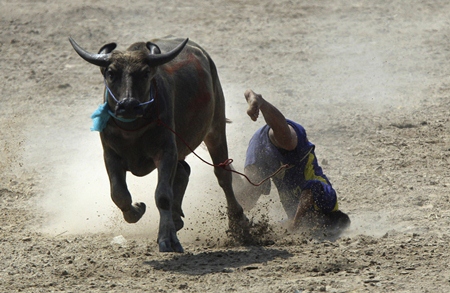 Ouch! A buffalo jockey falls off his “steed” during the annual water buffalo race in Chonburi on Monday, Oct. 29. (AP Photo/Sakchai Lalit)
Ouch! A buffalo jockey falls off his “steed” during the annual water buffalo race in Chonburi on Monday, Oct. 29. (AP Photo/Sakchai Lalit)
Merchants would park their carts near the market and the water buffalo were tethered off to the side to rest, or taken to bathe following the trip into town where lotus flowers were collected for offerings at the temple. Presumably, there were some fun-seeking individuals at the annual gathering who, at the end of Buddhist Lent and before leaving Chonburi, would gather and race their buffalo for a bit of fun and camaraderie. Water buffalo races eventually became a common reoccurrence each year.
During the reign of King Rama VI, His Majesty King Mongkut visited Chonburi and proudly witnessed the event on December 7, 1912, which helped commemorate the event to this day. Other records indicate that Rama V also witnessed the buffalo races in Chonburi, remarking that the enjoyable event should be preserved as a national tradition.
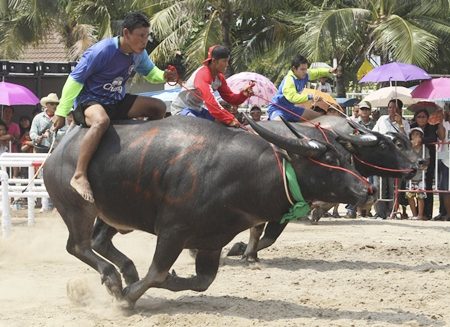 Nose to nose out of the starting gate. (AP Photo/Sakchai Lalit)
Nose to nose out of the starting gate. (AP Photo/Sakchai Lalit)
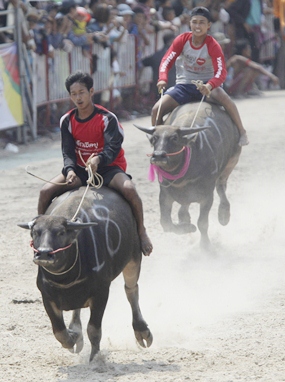 Number 18 pulls out to a big lead in this heat. (AP Photo/Sakchai Lalit)
Number 18 pulls out to a big lead in this heat. (AP Photo/Sakchai Lalit)
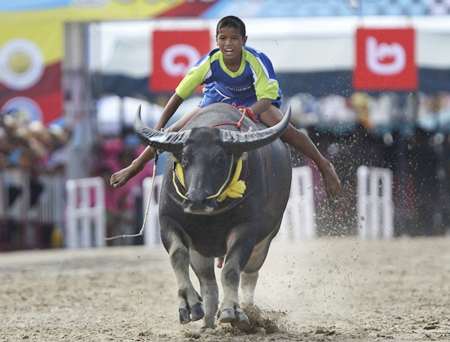 Although he is just a young boy, this jockey seems to be right at home racing his monstrous “thoroughbred”. (AP Photo/Sakchai Lalit)
Although he is just a young boy, this jockey seems to be right at home racing his monstrous “thoroughbred”. (AP Photo/Sakchai Lalit)
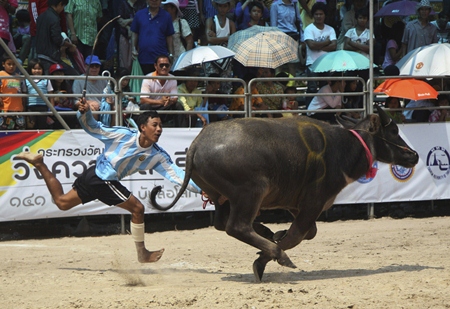 Hey! Come back here, you! (AP Photo/Sakchai Lalit)
Hey! Come back here, you! (AP Photo/Sakchai Lalit)
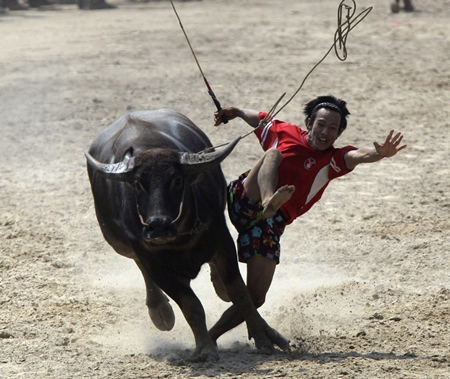 A jockey on these beasts and at these speeds can only hold on for so long. (AP Photo/Sakchai Lalit)
A jockey on these beasts and at these speeds can only hold on for so long. (AP Photo/Sakchai Lalit)
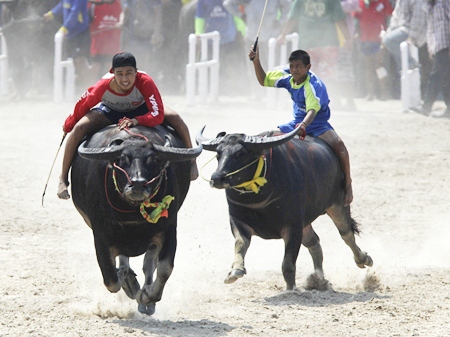 The bigger they are, the harder they are to control! (AP Photo/Sakchai Lalit)
The bigger they are, the harder they are to control! (AP Photo/Sakchai Lalit)
